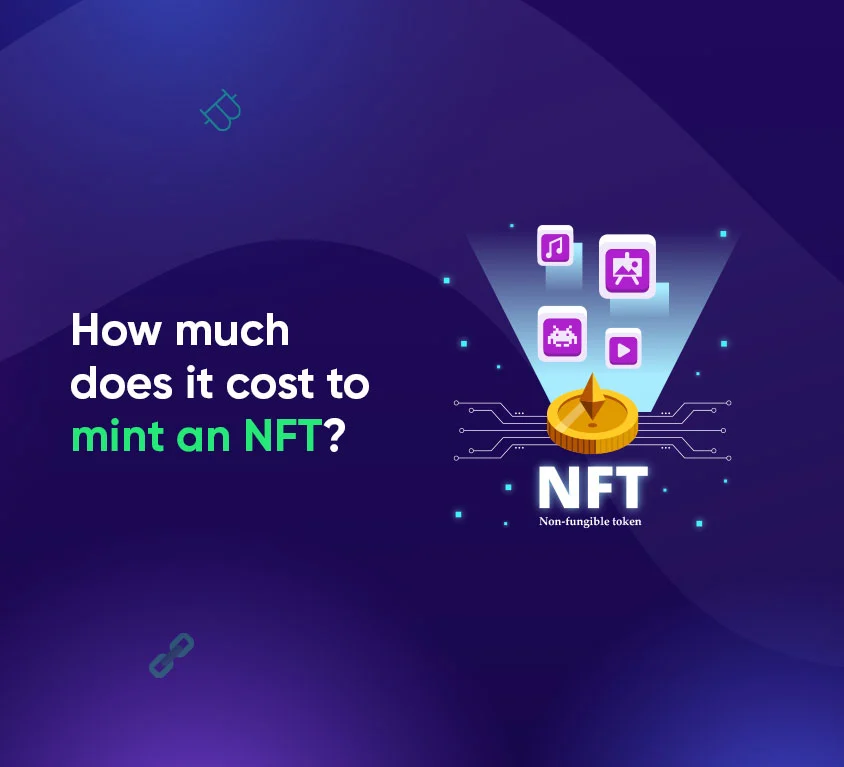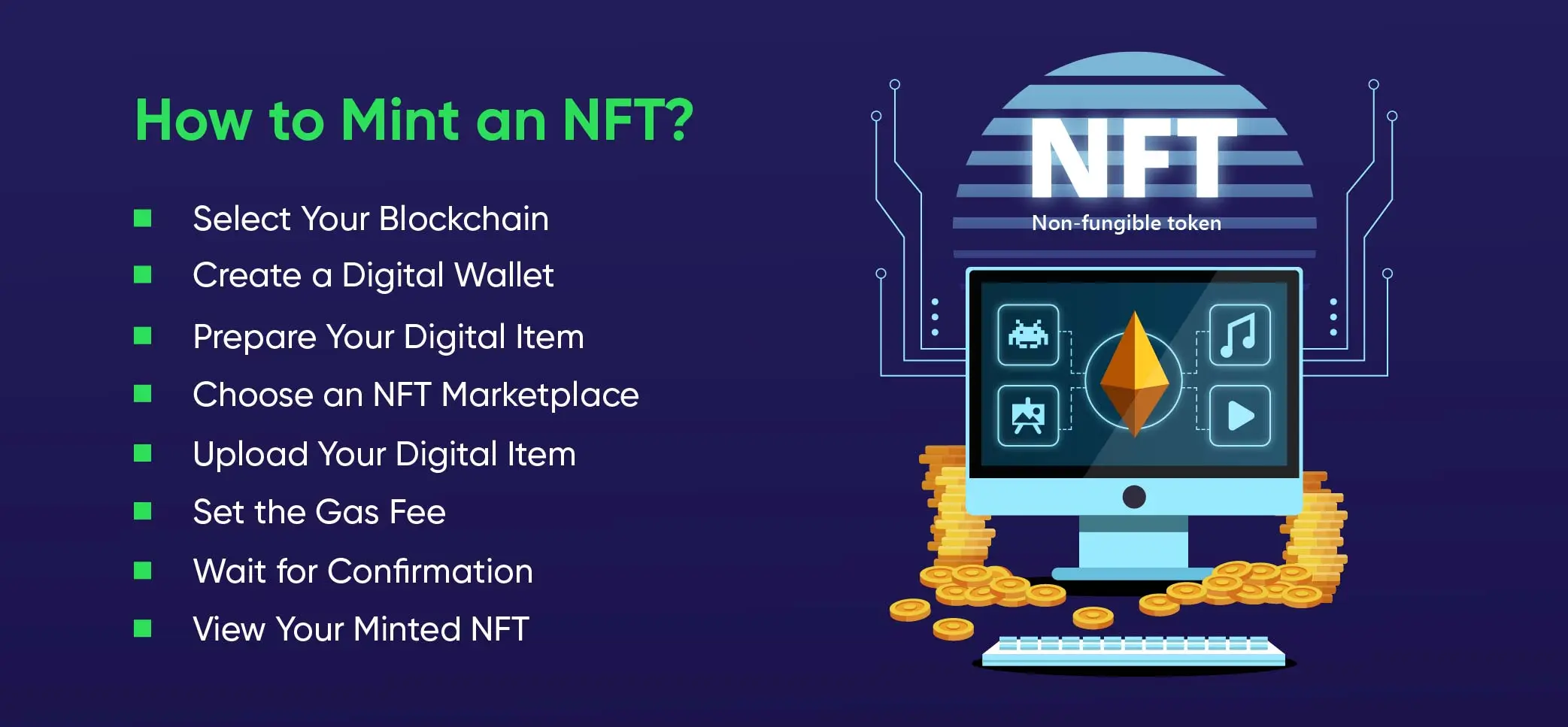
Introduction
Web3 & Blockchain Consultancy :
How much does it cost to mint an NFT?
In the NFT community, digital art, collectibles, and unique assets are most important. But, one question arises here: “How much does it cost to mint an NFT?” We spread knowledge for NFT enthusiasts and newcomers alike by uncovering the complexities of NFT minting costs. Moreover, NFTs, or Non-Fungible Tokens are reshaping how we perceive and interact with digital assets. The NFT community is going to experience digital ownership and self-expression, and it’s becoming important to understand the intricacies of NFT minting, including the costs involved. In this guide, we’ll help you navigate NFTs the factors that influence minting costs, the technical nuances of the process, and the impact of blockchain networks. Before delving into how much it costs to mint an NFT, you should read how much it costs to create an NFT.What is NFT Minting?

How to create an NFT?
- Firstly, you will need to select a blockchain network (commonly Ethereum or Binance Smart Chain)
- Secondly, upload the digital item to the chosen platform. The blockchain records the item’s information and generates a token, which is the NFT.
- Lastly, This token is securely stored on the blockchain and can be bought, sold, or traded, proving ownership of the original digital asset.
Significance of NFT Minting in the NFT Community
NFT minting is the bolt of the NFT ecosystem as It empowers artists, creators, and collectors by allowing them to tokenize their digital creations, ensuring the uniqueness and scarcity of their items. The NFT creation process not only gives a sense of ownership but also serves as a prove of the authenticity of digital collectibles that as a result creates a vibrant and trustworthy marketplace for NFT enthusiasts.Factors that influence NFT Minting Costs
- Gas Fees and Blockchain Networks: Minting NFTs often incurs gas fees. Moreover, the blockchain network chosen significantly affects these fees.
For example
-
- Ethereum has high gas costs, which can make minting expensive.
- Binance Smart Chain offers a more cost-effective alternative.
- Artistic Complexity and File Size: The complexity and size of the digital item have a lot to do with minting costs. Large files can demand higher gas fees due to the computational power required to process them.
- Rarity and Collectibility: The rarity and perceived collectibility of an NFT can influence its minting cost. Unique, limited-edition, and highly sought-after items often command higher prices in the minting process.
- Environmental Concerns: Minting NFTs on energy-intensive blockchains like Ethereum can raise ecological issues and, in some cases, affect minting costs.
- Scalability Issues: With popularity, scalability becomes a factor in minting costs. Blockchains need to accommodate increasing activity, and this can lead to scalability challenges, potentially impacting costs.
 The insight above influences what kind of NFTs gain value and popularity.
The insight above influences what kind of NFTs gain value and popularity.
How much does it cost to mint an NFT?
The cost of minting an NFT can depend on factors like the blockchain network, gas fees, and the complexity of the digital asset being tokenized. Typically, minting an NFT can cost anywhere from a few dollars to hundreds of dollars. The cost is determined by the expenses associated with interacting with the blockchain and the specific platform or marketplace you use for minting.Comparing Gas Fees
Gas fees can vary significantly depending on the blockchain network you choose for minting your NFTs. The most notable examples include:
Blockchain Network |
Gas Fee Status |
|---|---|
Ethereum |
High Gas Fee | due to its popularity and the computational intensity of its smart contracts. |
Polygon (MATIC) |
Low Gas Fee | Layer 2 scaling solution for Ethereum has become a preferred choice for creators looking to minimize minting costs. |
BSC |
Lower Gas Fee | an attractive option for minting cost-conscious NFT creators. |
Tezos |
Competitive Gas Fee | A blockchain focused on sustainability, designed to provide a cost-effective minting environment while considering environmental concerns. |
Impact of Blockchain Network Choice
Factors |
Impact |
|---|---|
Artistic Complexity and File Size |
Larger NFTs may require more computational resources and result in higher gas fees. |
Rarity and Collectibility |
Some NFTs, by nature of their rarity and uniqueness, may involve complex smart contracts and, consequently, higher gas fees. The blockchain you select can help manage these costs. |
Environmental Concerns |
NFT minting on blockchains like Ethereum can raise environmental concerns due to their energy consumption. Blockchain networks like Tezos focus on environmental sustainability while maintaining reasonable minting costs. |
Scalability Issues |
High gas fees can be a sign of scalability issues on a blockchain network. While some networks are actively addressing these concerns, minting on more scalable platforms can reduce costs. |
Best Practices for Cost-Effective Minting
- If cost-effectiveness is a priority, consider blockchains like Binance Smart Chain or Flow. They offer lower gas fees for minting NFTs.
- Mint multiple NFTs in a single transaction to optimize gas fees.
- Be mindful of your budget for minting, including gas fees and any royalties you may need to pay.
- Consider the rarity and utility of your NFT. High-quality, rare, and functional NFTs tend to be more cost-effective to mint, as collectors often gravitate towards such items.
- Keep an eye on blockchain developments and scalability solutions. Changes in blockchain technology can significantly impact minting costs.
- Minting and mining are distinct processes within the NFT and blockchain ecosystem.
NFT Minting vs NFT Mining
Aspect |
NFT Minting |
NFT Mining |
|---|---|---|
| Definition | Creating NFTs by tokenizing digital assets. | Validating transactions and adding them to the blockchain. |
| Complexity | Typically involves paying fees to secure a spot on the blockchain. | Requires solving complex cryptographic puzzles through computational work. |
| Competition | Does not involve competing with others. | Often involves competition among miners to solve puzzles and earn rewards. |
| Role | Focuses on the creation of digital assets as NFTs. | Focused on maintaining the security and integrity of the blockchain network. |
| Reward | Minters may incur costs for minting NFTs. | Miners are rewarded with cryptocurrency tokens (e.g., Bitcoin or Ethereum) for their work. |
| Network Impact | Primarily affects the NFT minting process. | Primarily impacts the validation and security of blockchain transactions. |
| Usage | Used by creators, artists, collectors, and NFT marketplaces. | Primarily used by miners and blockchain network participants. |
The Future of NFT Minting Costs
- Blockchain Technology Advancements: Blockchain technology is continually evolving, with developers working to enhance scalability and reduce gas fees. With these advancements, minting costs could decrease over time.
- Market Saturation: The NFT market may experience saturation, leading to increased competition among creators. As a result, some artists and collectors might explore cost-efficient ways to mint NFTs.
- Regulation and Compliance: Government regulations could impact NFT minting costs. Compliance requirements and associated costs may arise, affecting how NFTs are created and distributed.
- Community Initiatives: NFT communities and platforms may introduce initiatives to address cost concerns. Crowdsourced solutions and community-driven efforts could lead to more affordable minting options.
Solutions to Mitigate High Costs
- Layer 2 Scaling Solutions: Layer 2 solutions, like Ethereum’s Optimistic Rollups and sidechains, aim to reduce the congestion and gas fees on the Ethereum network. These innovations enable more cost-effective minting processes. In case, you are interested in getting an L2 solution, Bloxbytes is a blockchain development company that has excellence in providing comprehensive blockchain development services to their clientele worldwide.
- Cross-Chain Compatibility: As blockchain networks continue to proliferate, NFT creators have the option to mint on various blockchains, each with its fee structure. This diversity promotes competition and cost-efficiency.
- Eco-Friendly Blockchains: Eco-friendly blockchains, which have lower environmental impacts, may gain prominence. Such networks can offer minting at a lower ecological and financial cost.
- NFT Marketplaces and Tools: NFT marketplaces and development tools are continually improving. Some are introducing features that optimize minting costs and streamline the process.
Conclusion
The question “How much does it cost to mint an NFT?” has been answered in this article in detail. As we conclude, let’s summarize the key takeaways:- NFT minting costs vary widely based on factors such as blockchain network, gas fees, artistic complexity, rarity, and environmental considerations.
- Ethereum and Binance Smart Chain are popular choices for minting NFTs, but other networks offer cost-effective alternatives.
- By considering gas fee optimization, blockchain selection, and eco-friendly solutions, artists and collectors can mitigate NFT minting costs.
- Continuously educate yourself on the latest cost-effective strategies for NFT minting.
- Take the Next Step with BloxBytes